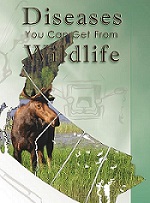Wildlife health
Healthy wild animal populations are of great importance to people living in British Columbia. Animals contribute to healthy environments and healthy tourism and recreation economies. Wildlife diseases are a health risk to wild animals, domestic animals and humans they interact with.
On this page
Wildlife health alerts
The following are current wildlife health alerts for B.C. Learn what to do if you find sick, injured or dead wildlife.
The B.C. government is tracking the outbreak of a possible new disease in deer on the coast. For more information, view the fact sheet on Adenovirus Hemorrhagic Disease in Deer (PDF, 153KB)
Wildlife health fact sheet - Feeding wild ungulates - February 28, 2023
Keep wildlife wild – it is B.C. policy and it makes sense. When humans provide food to wild animals it changes their “wildness”, no matter what species is being fed. There are justifiable reasons to feed wild animals, such as to attract them for capture, but these situations are rare. The consequences of feeding a wild animal unnatural types and amounts of feed can range from mildly irritating behaviour to catastrophic health issues, so a full understanding of the reasons is important.
Highly Pathogenic Avian Influenza - April 2022
Highly Pathogenic Avian Influenza (HPAI; H5N1) was first detected in Canada in the Atlantic Provinces in December 2021 and is now spreading across Canada and the United States. For more information, view the fact sheet on Highly Pathogenic Avian Influenza (PDF, 162KB)
Read more:
- Review the factsheet and help stop the spread of Avian Influenza (PDF, 659KB)
Newcastle Disease in Pigeons - February 11, 2021
A virulent strain of Paramyxovirus (PMV) has recently been detected in free-ranging pigeons in North Vancouver. Paramyxoviruses are in a family of bird viruses with variability in species susceptibility and their ability to cause disease; this strain appears to be pigeon-adapted (pPMV).
PMV causes “Newcastle Disease” in poultry and does create significant risk to the poultry industry as well as pet pigeons and doves if there is transmission. While poultry are less likely to show disease, infection could result in industry-wide impacts. Fortunately, since this site is distant to poultry farms the risk is reduced.
Signs of infection usually appear after a 2-12 day incubation period and may be sub-clinical (no signs), mild to moderate (depression, thirst, green diarrhea, stop egg laying) or severe (twisted necks, incoordination, loss of balance, gasping, muscle tremors, death).
Human health – on rare occasions exposure to PMV has caused temporary conjunctivitis (pink eye) in humans but does not cause significant disease in humans.
Spread of pPMV is through movement of infected birds, contaminated equipment, footwear, or manure. Good biosecurity measures should prevent the introduction of the virus to susceptible birds.
To stop the spread of PMV to susceptible birds, strong biosecurity practices are advised:
- Quarantine incoming pigeons and doves
- Keep feeders inside the coop to discourage mixing of domestic and free-ranging birds
- Remove manure and soiled bedding frequently
- Wear gloves when handling pigeons
- Wash hands, footwear, and remove soiled clothing between birds
Disease Alert: Paramyxovirus in North Shore Wild Pigeons (PDF, 357KB)
Caring for wild animal populations
People who protect and manage wildlife and people who protect and manage the environment must work together, as wild animals and the environment they live in rely on each other to be healthy. We call this approach to studying and managing wildlife health in B.C. Wildlife Health Matters.
B.C. Wildlife Health Program
The B.C. Wildlife Health Program aims to improve our understanding of factors affecting wild animal health in B.C., by monitoring diseases and parasites. These data are used to explore the effects of diseases and parasites upon animal populations over time, and to show how such changes relate to changes in the environment. Several diseases affecting wildlife, domestic animals, humans and the economy are prioritized for study.
B.C.’s Wildlife Health Program also:
- Cooperates with and advises the public, First Nations communities, interest groups, non-governmental agencies, other government agencies and researchers, at a local, national and international level, on issues related to wild animal care, wildlife conservation and the health effects from interactions among wildlife, domestic animals and humans.
- Provides technical information, support and field assistance to communities, species at risk recovery programs, conservationists, hunters, trappers, and other wildlife professionals.
Report Animals
Read the booklet Diseases You Can Get From Wildlife (PDF, 7.3MB)
Learn about Safe Game Meat Handling (PDF, 149 KB)
Contact information
For wildlife-human interactions where public safety may be at risk call the Report All Poachers and Polluters (RAPP) line:
For wildlife health inquiries or reports:
250 751-7246

